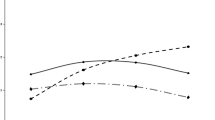Abstract
The impact of children’s use of “screen” media including television and computer games, continues to be debated. The American Academy of Pediatrics (AAP) until recently recommended a relatively restrictive screen time diet of 2 h or less for most youth. A representative correlational sample of youth were assessed for links between screen time and risky behavioral outcomes. Data collection occurred in 2013 conducted by the State of Florida. Use of screens that was moderately high, in excess of the AAP’s former recommendations, but not excessive (1 SD or higher than average), was not associated with delinquency, risky behaviors, sexual behaviors, substance abuse, reduced grades or mental health problems. Even excessive screen use (1 SD or higher) was only weakly associated with negative outcomes related to delinquency, grades and depression only, and at levels unlikely to be practically significant. Results conceptually replicate those of Przybylski (2014) with a US sample for depression and delinquency as outcomes. Moderate use of screens, though in excess of the AAP’s historical recommendations, are unassociated with problem outcomes. Excessive use of screens is only weakly associated with negative outcomes, and only those related to depression and delinquency as well as reduced grades, but not risky driving, substance use, risky sex or disordered eating. Although an “everything in moderation” message when discussing screen time with parents may be most productive, results do not support a strong focus on screen time as a preventative measure for youth problem behaviors.
Similar content being viewed by others
References
Hale L, Guan S. Screen time and sleep among school-aged children and adolescents: a systematic literature review. Sleep Medicine Reviews. June 2015;21:50–58.
Zero to Three. Screen sense: Setting the record straight. Retrieved from: http://www.zerotothree.org/parenting-resources/screen-sense/
Laurson K, Lee J, Eisenmann J. The cumulative impact of physical activity, sleep duration, and television time on adolescent obesity: 2011 youth risk behavior survey. Journal of Physical Activity & Health. March 2015;12(3):355–360.
Linebarger D, Vaala S. Screen media and language development in infants and toddlers: an ecological perspective. Developmental Review. June 2010;30(2):176–202.
Gentzkow M, Shapiro J. Preschool television viewing and adolescent test scores: historical evidence from the Coleman study. The Quarterly Journal of Economics. 2008; 123: 279–323.
Schwartz J, Beaver K. Revisiting the association between television viewing in adolescence and contact with the criminal justice system in adulthood. Journal of Interpersonal Violence. In Press.
Holmstrom A. The effects of the media on body image: a meta-analysis. Journal Of Broadcasting & Electronic Media. 2004;48(2):196–217.
Hittner J. How robust is the Werther effect? A re-examination of the suggestion-imitation model of suicide. Mortality. August 2005;10(3):193–200.
Pryzbylski A. Electronic gaming and psychosocial adjustment. Pediatrics. 2014
Allahverdipour H, Bazargan M, Farhadinasab A, & Moeini B. Correlates of video games playing among adolescents in an Islamic country. BMC Public Health. 2010; 10: 286.
Kutner L, Olson C. Grand theft childhood: the surprising truth about violent video games and what parents can do. New York: Simon & Schuster; 2008.
Centers for Disease Control and Prevention. Methodology of the youth risk behavior surveillance system. MMWR 2004 53(No. RR-12):1–14.
Anatale K, Kelly S. Factors influencing adolescent girls’ sexual behavior: a secondary analysis of the 2011 youth risk behavior survey. Issues In Mental Health Nursing. 2015;36(3):217–221.
Belamarich PF, Gandica R, Stein RE, Racine AD. Drowning in a sea of advice: pediatricians and American Academy of Pediatrics policy statements. Pediatrics. 2006;118(4). doi:10.1542/peds.2006-0652
Author information
Authors and Affiliations
Corresponding author
Ethics declarations
Conflict of Interest
The author has no conflicts of interest to declare and is solely responsible for the study design, analysis and decision to submit for publication. The author received no grants, honorarium or other funding to contribute to this report.
Human and Animal Rights
All procedures performed in studies involving human participants were in accordance with the ethical standards of the institutional and/or national research committee and with the 1964 Helsinki declaration and its later amendments or comparable ethical standards.
Informed Consent
Informed consent was obtained from all individual participants included in the study.
Rights and permissions
About this article
Cite this article
Ferguson, C.J. Everything in Moderation: Moderate Use of Screens Unassociated with Child Behavior Problems. Psychiatr Q 88, 797–805 (2017). https://doi.org/10.1007/s11126-016-9486-3
Published:
Issue Date:
DOI: https://doi.org/10.1007/s11126-016-9486-3




